Compare these two birds:
 |
| Great Blue Heron |
|
 |
| Sandhill Crane |
|
About half of the non-birders you know call the bird on the left a "blue crane." Despite the similar long legs, long neck, and pointed bill, other anatomical features are quite different. Taxonomists would say that these birds are not closely related. Most field guides are arranged taxonomically,
to help scientists understand bird relationships. Thus, you will not find these birds near each other in most field guides. This is confusing for beginners trying to identify a bird they saw.
Next:
 |
| American Coot |
|
 |
| Pied-billed Grebe |
|
Look at these swimming waterbirds above. Both share the dark coloration, white chicken-like bill with dark ring, fluffy short tail, and lobed toes. However, these birds are not closely related taxonomically. They are not found near each other in most field guides. Beginners find this confusing.
Want to know something even more confusing? The crane and the coot above share many internal anatomic structures and are considered very closely related. Thus, they are found near each other in the field guides!
Field guides are not user-friendly for beginning birders.
Yet, if you want a simpler "beginner" guide, you'll soon find that many of the birds you'll see day-to-day won't be in it. There aren't just common birds and rare birds. There's a full spectrum from birds seen every day to birds seen twice per season. There are too many birds that are likely to be seen sporadically that are left out of simpler guides. Often, a beginner guide may only show breeding males of the most common species. A field guide based on color, you say? Then what about differently-colored females? What about strikingly varied winter plumage? What about dissimilar-looking younger birds?
Enter the
Field-Friendly Bird Sequence.
In this sequence, birds that look alike, structurally, or share obvious habitat or behavioral similarities, are found near each other in the guide book. Thus, no matter how often the taxonomic relationship is shuffled in the future, the field guide can stay pretty much the same.
In such a field-friendly arrangement,
designed to help beginners identify birds, the heron and the crane would be together in the group of Wading Waterbirds. The coot and the grebe would be together in the group of Swimming Waterbirds. And the coot and the crane would be farther apart in such a field guide.
A few field guides were actually produced using variations of the field-friendly sequence. My favorite, as far as grouping similar birds together, was the
Kaufman Focus Guide to Birds of North America. 2000. Kenn Kaufman (now the
Kaufman Field Guide to Birds of North America. 2005.). But it wasn't as good as I thought it could be.
So I created my own field-friendly sequence in 2012 (
blog post here). Using this sequence, North American birds can be placed into one of 13 field-friendly categories. The best part? You probably already know at least one bird in each category. Most non-birders can quickly place a bird they see into one of these 13 categories. All similar birds would then be near each other in the field guide.
The 13 categories are:
Swimming Waterbirds
Flying Waterbirds
Wading Waterbirds
Chicken-like Birds
Raptors
Miscellaneous Landbirds
Aerial Landbirds
Flycatcher-like Birds
Thrush-like Songbirds
Chickadee & Wren-like Songbirds
Warbler-like Songbirds
Sparrow & Finch-like Songbirds
Blackbird-like Songbirds
|
If you learn a couple of birds in each of the 13 categories you are more likely to identify a new bird that you observe. This sequence should make it easier for beginners or non-birders to look up a bird and get to the correct grouping. Of course, birds are highly varied and complex. So there will always be some complaint with any system that tries to simplify them--this arrangement is no different.
Here are the overviews of each category:
(Sadly, the following charts do not display correctly on all mobile devices--use a PC or laptop, if possible.) From a smart phone, go to the bottom of the page and select "view web version."
| Swimming Waterbirds |
 |
| Mallard |
| Swimming Waterbirds are primarily web-footed birds most-frequently observed swimming. Oh, many are strong fliers, but these search for food in the water or graze on the ground near water. They spend a great amount of time swimming or even diving under the water.
Included families: Ducks, geese, swans, grebes, coots, alcids (auks and puffins), loons, pelicans, boobies, and cormorants. |
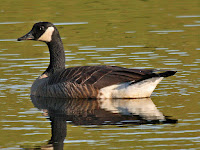 |
| Canada Goose |
|
 |
| Common Merganser |
|
 |
| Clark's Grebe |
|
 |
| Common Loon |
|
 |
| Pigeon Guillemot |
|
 |
| Double-crested Cormorant |
|
 |
| Tundra Swan |
|
 |
| Common Gallinule |
|
 |
| Blue-winged Teal |
|
 |
| Brown Pelican |
|
 |
| Brown Booby |
|
 |
| Common Murre |
|
| Flying Waterbirds |
 |
| Western Gull |
| Flying Waterbirds can and do swim on the water, however they spend more of their time flying over the water looking for food. When they do find food, they often either pick the food off the water and keep flying or plunge-dive into the water from flight. Many of these are restricted to ocean waters.
Included families: Skuas, gulls, terns, skimmers, albatrosses, shearwaters, and petrels. |
 |
| Ring-billed Gull |
|
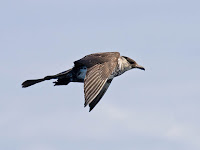 |
| Pomarine Jaeger |
|
 |
| Elegant Tern |
|
 |
| Black-footed Albatross |
|
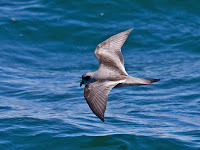 |
| Fork-tailed Storm-Petrel |
|
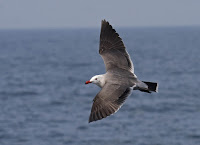 |
| Heermann's Gull |
|
 |
| Northern Fulmar |
|
 |
| Black Skimmer |
|
 |
| Pink-footed Shearwater |
|
| Wading Waterbirds |
 |
| Great Blue Heron |
| Wading Waterbirds are often long-legged and long-necked. Many have longer bills for probing in mud or sand for invertebrate food, or stabbing fish. Though most are found in wetlands or on beaches, some can forage in pastures and open grasslands.
Included families: Rails, shorebirds (plovers, curlews, stilts, oystercatchers, sandpipers), herons, cranes, and ibis. |
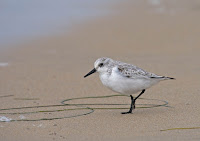 |
| Sanderling |
|
 |
| White-faced Ibis |
|
 |
| Long-billed Curlew |
|
 |
| Sora |
|
 |
| American Avocet |
|
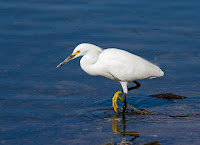 |
| Snowy Egret |
|
 |
| Killdeer |
|
 |
| Black-crowned Night-Heron |
|
 |
| Baird's Sandpiper |
|
 |
| Wilson's Snipe |
|
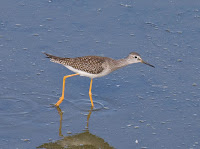 |
| Lesser Yellowlegs |
|
 |
| Green Heron |
|
| Chicken-like Birds |
 |
| Wild Turkey |
| Chicken-like Birds are familiar game birds known to all. Small bills, strong legs, plump bodies are typical.
Included families: Grouses, quails, pheasants, turkeys. |
 |
| Ring-necked Pheasant |
|
 |
| California Quail |
|
 |
| Chukar |
|
| Raptors |
 |
| Red-tailed Hawk |
| Raptors are birds of prey that hunt other animals or birds for food with an aerial attack. Strong beaks and claws. Many can be seen soaring high overhead on thermals, while others hunt low from a concealed perch.
Included families: Vultures, hawks, eagles, owls, falcons. |
 |
| Turkey Vulture |
|
 |
| Bald Eagle |
|
 |
| Osprey |
|
 |
| American Kestrel |
|
 |
| Great Horned Owl |
|
 |
| Barn Owl |
|
 |
| Peregrine Falcon |
|
 |
| Cooper's Hawk |
|
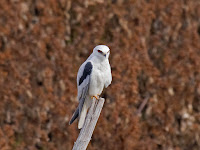 |
| White-tailed Kite |
|
| Miscellaneous Landbirds |
 |
| Domestic Pigeon |
| Miscellaneous Landbirds are a category of odds-and-ends birds. Generally larger birds that don't fit into the above categories. Members of this groups are known by most people--even non-birders.
Included families: Pigeons, roadrunners, cuckoos, kingfishers, woodpeckers, parrots, and jays and crows. |
 |
| Northern Flicker |
|
 |
| Red-crowned Parrot |
|
 |
| American Crow |
|
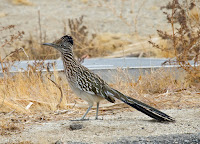 |
| Greater Roadrunner |
|
 |
| Belted Kingfisher |
|
 |
| California Scrub-Jay |
|
 |
| Mourning Dove |
|
 |
| Hairy Woodpecker |
|
 |
| Red-breasted Sapsucker |
|
| Aerial Landbirds |
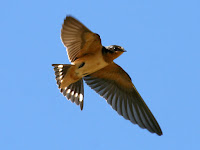 |
| Barn Swallow |
| Aerial Landbirds generally feed on the wing and spend most of their waking hours flying, chasing flying insects for food.
Included families: Nightjars (nighthawks and whip-poor-wills), hummingbirds, swallows, swifts. |
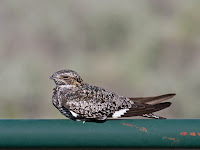 |
| Common Nighthawk |
|
 |
| Allen's Hummingbird |
|
 |
| Vaux's Swift |
|
 |
| Tree Swallow |
|
 |
| Purple Martin |
|
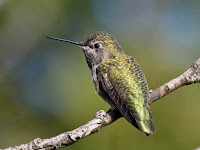 |
| Anna's Hummingbird |
|
| Flycatcher-like Birds |
 |
| Western Kingbird |
| Flycatcher-like Birds: Tyrant flycatchers, found only in the Americas, are the world's largest family of birds with over 400 species. Medium to small birds, primarily drab greens, yellows, grays, and browns. Perch upright with large head, flat bill, and ample tail. Many remain motionless until they sally out to grab a larger flying insect, then often return to the same perch.
Included families: Flycatchers, phainopeplas, waxwings |
 |
| Western Wood-Pewee |
|
 |
| Phainopepla |
|
 |
| Gray Flycatcher |
|
 |
| Cedar Waxwing |
|
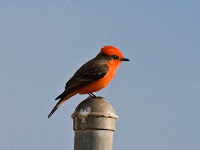 |
| Vermilion Flycatcher |
|
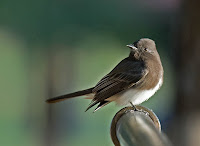 |
| Black Phoebe |
|
| Thrush-like Songbirds |
 |
| American Robin |
| Thrush-like Songbirds are a diverse group of medium-sized land birds. Most with long bodies, long tails, and thinner pointed bills suitable for eating insects rather than seeds. Often found on the ground or in larger tree branches.
Included families: Shrikes, larks, bluebirds and thrushes, thrashers and mockingbirds, dippers, pipits, tanagers, meadowlarks, orioles. |
 |
| Hermit Thrush |
|
 |
| Townsend's Solitaire |
|
 |
| Western Bluebird |
|
 |
| Northern Mockingbird |
|
 |
| California Thrasher |
|
 |
| Loggerhead Shrike |
|
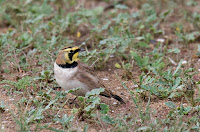 |
| Horned Lark |
|
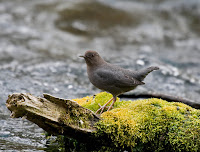 |
| American Dipper |
|
 |
| American Pipit |
|
 |
| Western Tanager |
|
 |
| Western Meadowlark |
|
 |
| Hooded Oriole |
|
| Chickadee & Wren-like Songbirds |
 |
| Black-capped Chickadee |
| Chickadee & Wren-like Songbirds are a diverse group of small, plump, active, primarily gray or brown land birds. All are insect eaters, though some eat seeds by pounding them open with their bills, as they cannot chew. Often found in brush or tangles or smaller tree branchlets.
Included families: Chickadees, verdins, bushtits, nuthatches, creepers, wrens, wrentits, and gnatcatchers. |
 |
| Chestnut-backed Chickadee |
|
 |
| Red-breasted Nuthatch |
|
 |
| Brown Creeper |
|
 |
| Bushtit |
|
 |
| Oak Titmouse |
|
 |
| Verdin |
|
 |
| California Gnatcatcher |
|
 |
| Wrentit |
|
 |
| Bewick's Wren |
|
| Warbler-like Songbirds |
 |
| Yellow-rumped Warbler |
| Warbler-like Songbirds are small to very small birds, with short, thin, bills. Green is a predominate color, but many warblers are colorfully patterned in yellows and black and white. Vireos are sluggish, others are active to hyperactive. Often glean for insects in the foliage of trees.
Included families: Vireos, kinglets, warblers. |
 |
| Golden-crowned Kinglet |
|
 |
| Cassin's Vireo |
|
 |
| Yellow-rumped Warbler |
|
 |
| Common Yellowthroat |
|
 |
| Yellow Warbler |
|
 |
| Orange-crowned Warbler |
|
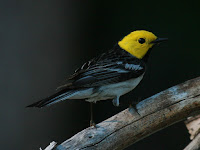 |
| Hermit Warbler |
|
 |
| Townsend's Warbler |
|
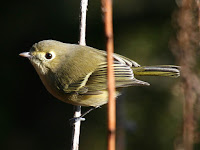 |
| Hutton's Vireo |
|
| Sparrow & Finch-like Songbirds |
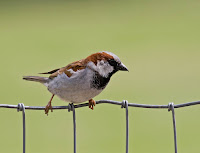 |
| House Sparrow |
| Sparrow & Finch-like Songbirds are a large group of seed-eaters that have conical bills, sometimes quite thick. Ground-dwelling sparrows are patterned or streaked in brown and grays; tree-loving male finches are colorful, but females are usually streaked brownish like sparrows. Look for these birds at your backyard feeders.
Included families: Sparrows, munias, weavers, finches, longspurs, towhees, juncos, grosbeaks, and buntings. |
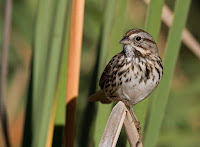 |
| Song Sparrow |
|
 |
| House Finch (female) |
|
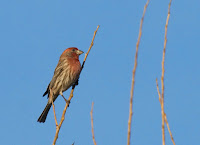 |
| House Finch (male) |
|
 |
| Lesser Goldfinch |
|
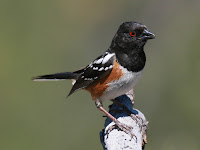 |
| Spotted Towhee |
|
 |
| White-crowned Sparrow |
|
 |
| Dark-eyed Junco |
|
 |
| Blue Grosbeak |
|
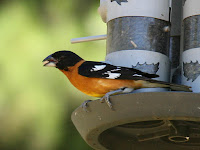 |
| Black-headed Grosbeak |
|
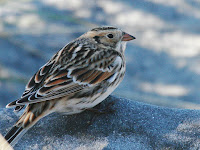 |
| Lapland Longspur |
|
 |
| Red Crossbill |
|
 |
| Evening Grosbeak |
|
 |
| Lazuli Bunting |
|
 |
| Scaly-breasted Munia |
|
 |
| Lark Sparrow |
|
| Blackbird-like Songbirds |
 |
| Red-winged Blackbird |
| Blackbird-like Songbirds are medium-sized (smaller than crows) blackish or brownish birds often forming large winter flocks. Have longer, more pointed bills.
Included families: Starlings, blackbirds, cowbirds, grackles, bobolink. |
 |
| European Starling |
|
 |
| Great-tailed Grackle |
|
 |
| Bobolink |
|
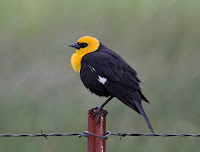 |
| Yellow-headed Blackbird |
|
 |
| Brown-headed Cowbird |
|
 |
| Brewer's Blackbird |
|







































































































































HI I live in San marcos,CA and have been watching a spotted thee for a couple of years..he's very fast and very hard to take a picture of him.I font see but one and I don't know what females look like.he stays but a sec and is great at hiding is this common?
ReplyDeleteYes, towhees like to hide low down in bushes and on the ground. Female Spotted Towhees may be slightly browner than makes, but look very similar.
DeleteThis comment has been removed by a blog administrator.
ReplyDelete